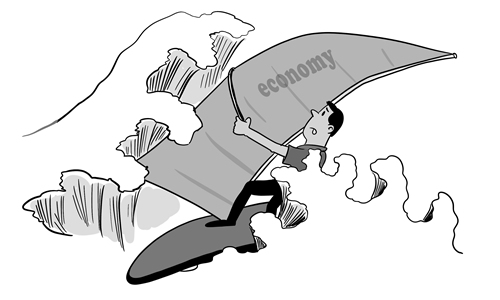HOME >> BUSINESS
Northeast China’s revitalization efforts need to go beyond economic restructuring
By Xiao Xin Source:Global Times Published: 2019/11/13 21:49:43

Illustration: Luo Xuan/GT
Northeast China, known as the "eldest son of the Republic," has not fared well amid an economic slowdown at large.But instead of scouring external factors that might have weighed on the rust-belt region, what we should do to genuinely revive the local economy is pinpoint the problems inherent in the region that used to act as a pivotal growth engine.
It's been a tough year for China's economy. A quarterly expansion of 6.0 percent in the third quarter marks the slowest growth since records were first published in March 1992. Behind the record low number are the nation's prolonged trade tensions with the US and global economic gloom.
Still, the sluggish economy of Changchun, capital city of Northeast China's Jilin Province, has shone a spotlight on growth woes persisting in northeastern China.
The city, whose name means "long spring" in Chinese, recorded zero economic growth in the first three quarters of the year, according to data released last week by the Changchun Bureau of Statistics. That suggests a decline of 0.5 percentage points from the first half.
A breakdown of the data showed that the total output for major industrial firms in the city fell 5.5 percent year-on-year in the first nine months. Fixed-asset investment plunged 16.9 percent year-on-year during the period, while imports and exports shrank 10.6 percent from the prior year.
The particularly poor economic performance could seemingly be tracked to the still-predominant role of heavy industry in the city's economy.
Jilin's economy, typified by heavy industry, saw the slowest growth among the three provinces in northeastern China. Its economy grew 1.8 percent in the first three quarters, compared with Heilongjiang's 4.3 percent and Liaoning's 5.7 percent, per official data.
In comparison, 17 provinces and cities posted growth rates above the national average of 6.2 percent in the first three quarters, the Securities Times reported in late October. Southwest China's Yunnan Province took the lead with an 8.8 percent growth in the first nine months.
In another sign of the rust-belt's shrinking influence in economic terms, the region's economy accounted for 13.98 percent of the nation's total back in 1978 when reform and opening-up began, and the ratio dropped to 6.48 percent in 2017 before falling to 6.3 percent in 2018, the 21st Century Business Herald reported in June, citing a blue book on regional economic development compiled by the Beijing Academy of Social Sciences.
Why has the "eldest son," whom the Chinese economy was once most proud of, taken a heavier hit from various uncertainties?
Admittedly, the region's economy, which fell into a downward spiral in 2013, has seen signs of a rebound over the past few years, owing to a raft of revitalizing measures. Efforts to rebalance the regional economy toward high-end smart manufacturing and services sectors have begun to take effect.
Nonetheless, the exacerbation of the external environment, notably the trade woes between the world's two largest economies, has thrust the region's economy into a fragile position.
That also means the region has largely failed a stress test. Southwest China's Guizhou Province, previously one of the most backward provinces, has over the years undergone a transformation in the hopes of catapulting it into a shining Chinese tech hub.
The three northeastern provinces' advanced manufacturing push, however, remains far from reshaping the local economy.
Worries often dominating local young people revolve around the struggle to pursue a career outside the region.
In an ironic portrayal of the region's growth struggle, an online post has recently gone viral on Chinese social media, telling the story of a 33-year-old from Zhoushan, East China's Zhejiang Province, who couldn't afford property in his hometown. He then settled down in Hegang, a declining city in Heilongjiang. The man forked out only some 50,000 yuan ($7,123.63) to purchase an apartment of more than 70 square meters.
The post which has turned the man into an internet celebrity has sounded a fresh warning of local economic travails. The revitalization push needs to go beyond economic restructuring efforts, meaning emerging sectors will need to play a much bigger part in the local economy and a heftier focus ought to be put on the region's institutional reforms. Only in so doing will both local talent and that from outside the region opt to build a career that's slated to remodel the rust belt into a new hub of the Chinese economy.
The author is a reporter with the Global Times. bizopinion@globaltimes.com.cn
Posted in: EXPERT ASSESSMENT